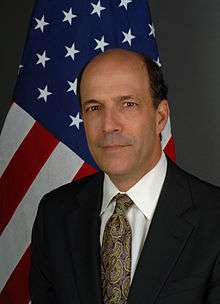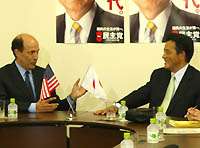John Roos
| John Roos | |
|---|---|
 | |
| 28th United States Ambassador to Japan | |
|
In office August 20, 2009 – August 12, 2013 | |
| President | Barack Obama |
| Preceded by | Tom Schieffer |
| Succeeded by | Caroline Kennedy |
| Personal details | |
| Born |
John Victor Roos February 14, 1955 San Francisco, California, U.S. |
| Alma mater | Stanford University |
John Victor Roos (born February 14, 1955) is a former United States Ambassador to Japan and former technology lawyer. Before accepting the ambassadorship from President Barack Obama, Roos was the CEO of Silicon Valley-based law firm of Wilson Sonsini Goodrich & Rosati.
Career
Wilson Sonsini Goodrich & Rosati
Roos was hired by Wilson Sonsini Goodrich & Rosati in 1985, having previously worked for O’Melveny & Myers in the early 1980s. The company caught the tech startup wave and over the next 25 years became the premier legal firm in the Valley, growing from 50 employees to more than 1,500 worldwide. Roos helped the firm to represent young companies such as Google, Hewlett Packard, and Pixar. After his appointment as CEO in 2004, he steered Wilson Sonsini beyond the burst tech bubble toward a broader client portfolio and a global presence. He also focused on workplace diversity, recognized when the firm was listed during his tenure as having the most diverse group of lawyers and Working Mother magazine named the firm as one of the "50 Best Law Firms for Women."[1]
Public Service and Political Activity
While building his legal career, Roos participated in political activities and community service. He ran for and won a seat on the San Mateo-Foster City School District Board of Trustees in 1991 and again in 1995. He also served in various capacitities at both Stanford University, where he served on the School of Education's Dean's Advisory Board and Stanford Law School—including as a member of the law school's Dean's Advisory Council. He was also elected to membership in the Stanford Associates for his long-standing volunteer service to the University.[2][3] Roos also served as an honorary captain—alongside John Elway—for Stanford before the Cardinal's victory in the January 2011 Orange Bowl.[4]
Roos supported Democrats including Mondale, Bradley, Kerry, and Obama, for whom he co-chaired the California financing operation.."[5]
Ambassadorship

In May 2009 Obama named Roos to replace the departing Tom Schieffer as United States Ambassador to Japan.[6]
On August 7, 2009, the U.S. Senate confirmed Roos by unanimous consent.[7] On August 16, 2009, Roos was formally sworn in as the new ambassador. Three days later he and his family arrived in Japan and on August 20 he presented his credentials to Emperor Akihito.[8]
Ambassador Roos' tenure in Japan coincided with a historic period in U.S.-Japan relations. Shortly after his arrival, the Democratic Party of Japan assumed power, the first real party transition in the Japanese government in 50 years. Roos played a key role in managing the relationship through that transition, as well as President Obama's rebalance to Asia, placing even more importance on the U.S.-Japan Alliance as the cornerstone of peace and security in the region. In addition to addressing the security, economic, and global challenges that Japan and the United States face, Roos has drawn a specific focus on areas of cooperation that include people to people connections, innovation, and entrepreneurship, and trade issues, including Japan's interest in joining the Trans-Pacific Partnership. He also works closely with Japan on issues related to the Hague Convention. During his time in Japan, Ambassador Roos built relationships and established a rich and active dialogue with government leaders, businesspeople, media and students over the course of his travels across all 47 of Japan's prefectures.[9]
On August 6, 2010, Roos attended the peace memorial ceremony in Hiroshima, the first US Ambassador to Japan to do so.[10] Survivors of the U.S. atomic bombing welcomed his historic presence, where he offered a silent prayer for the victims of the bombing. His attendance was seen as an important step to advance President Obama's agenda to eliminate nuclear weapons.[11] Roos returned to Hiroshima for the 2012 ceremony, and also became the first Ambassador to attend the Nagasaki memorial ceremony that year.[12] His attendance was reported by all Japanese news media and widely praised.
Following the devastating 9.0 earthquake, tsunami, and nuclear crisis on March 11, 2011, Ambassador Roos led the American mission to support Japan's response to the multi-dimensional and unprecedented disaster.[13] He made his first visit to Ishinomaki, one of the coast towns heavily damaged by the huge tsunami, just 12 days after the catastrophe, a visit he described as, "one of the most moving events of my life."[14] Roos led the coordination of American relief efforts in what he called "the world's first megadisaster." An hour after the earthquake, Roos declared an emergency and cleared the way for Operation Tomodachi—which means "friend" in Japanese—a massive relief operation. Nearly 200 U.S. military ships and aircraft transported food, clothing, and supplies to those left homeless. He also led the U.S. Embassy's response to the nuclear crisis that ensued when a 50-foot wave hit the Fukushima Dai-ichi nuclear power plant. The disaster was intensified by the limited information available during its initial hours. Roos led the U.S. government's communication, and he used his Twitter feed to assure that the 155,000 Americans living in Japan received timely information about the disaster.[15] The State Department awarded him the 2011 Sue M. Cobb Award for Exemplary Diplomatic Service for the "tireless and effective leadership he displayed during the unprecedented disaster," an honor the Ambassador credited to the extraordinary dedication shown by U.S. Embassy employees in the aftermath of the March 11 disasters.[16] Japanese public support of the United States reached historic highs (85% favorability) in the wake of the U.S. response to the disaster.[17] On November 15, 2011, Roos was the keynote speaker at the 27th Annual Dinner Gala of the Japanese Chamber of Commerce and Industry of New York.[18] Roos and Admiral Patrick Walsh are honored as leaders who helped strengthen the U.S.-Japan relationship after the 3.11 Tohoku earthquake and tsunami, depicted vividly and poignantly in a video "Arigato" from earthquake victims [19]
Roos also led the creation of the TOMODACHI Initiative in the wake of the U.S. relief efforts, after traveling throughout the Tohoku region that had been hit by the earthquake and tsunami and hearing from the mayor of one hard hit town, Rikuzentakata, that what the United States could really do to help recovery was "give hope to our young people." From this suggestion, the Ambassador launched the TOMODACHI Initiative.[20] The initiative is a public-private partnership with the U.S.-Japan Council, a Washington DC based organization, to invest in Japan's next generation of leaders. The Initiative represents a path-breaking paradigm in U.S. public diplomacy, in which government joins forces with private enterprises and organizations to achieve mutually beneficial, strategic goals. TOMODACHI provides young Japanese and Americans with opportunities to study, live, and work in each other's countries, thereby ensuring a thriving bilateral partnership into the foreseeable future. Roos marshaled assistance from a large number of high-profile celebrities to support the cause, including Lady Gaga, Tom Cruise, Will Smith, Cal Ripken, and will.i.am. Roos also has leveraged his popular Twitter account (over 55,000 followers, making him the most-followed U.S. Ambassador anywhere outside the United States) to share information and generate excitement, reaching hundreds of thousands or even millions through reTweets and amplifying the buzz. In its first year, TOMODACHI raised over 10 million dollars from corporations, organizations, and individuals, and has continued to grow. In the summer of 2012 alone, more than 450 young Japanese students from the Tohoku region travelled to the United States on various TOMODACHI-sponsored exchange programs. Roos' work with the TOMODACHI Initiative was recognized with the Special Gold Standard Award for Public Affairs Excellence in December 2012.[21]
In August 2013, Roos' term concluded. He was replaced by Caroline Kennedy.
Post-Ambassadorship
Ambassador Roos is currently CEO of The Roos Group, which is focused on strengthening ties between Silicon Valley and Japan in areas that include cross-border investment, venture capital, corporate growth, and the promotion of innovation and entrepreneurship. Ambassador Roos is a member of the Board of Directors at Salesforce.com and Sony Corporation and the Global Advisory Board of Mitsubishi UFJ Financial Group.[22][23][24]
On September 22, 2014, Ambassador Roos was awarded the Distinguished Public Service Award by Secretary of the Navy Ray Mabus for "his relentless efforts to forge a deeper bilateral security relationship between Japan and the United States," his "dynamic and steadfast leadership during Operation Tomodachi [that] paved the way for nearly 200 American ships and aircraft to transport essential relief supplies and equipment to the thousands left homeless after the March 2011 Tohoku earthquake and tsunami."
On October 10, 2015, Ambassador Roos was awarded the Warren M. Christopher International Lawyer of the Year award by The State Bar of California International Law Section.
Personal
Roos grew up in San Francisco and graduated from Lowell High School, before he went on to college at nearby Stanford University, where he graduated Phi Beta Kappa with Honors and Distinction, and Stanford Law School, earning his Juris Doctor in 1980, achieving Order of the Coif. Roos is married to his wife Susie, and has two children, Lauren and David.[25]
References
- ↑ Driscoll, Sharon. "Stanford Report". Retrieved 21 February 2013.
- ↑ Driscoll, Sharon. "Stanford Lawyer Profile: John V. Roos, the New Diplomat". Stanford Report. Retrieved 21 February 2013.
- ↑ U.S Embassy in Japan. "Official Bio". Retrieved 21 February 2013.
- ↑ Toman-Miller, Mary Ann. "U.S. Ambassador to Japan Speaks". Stanford Daily. Retrieved 21 February 2013.
- ↑ Driscoll, Sharon. "Stanford Report". Retrieved 21 February 2013.
- ↑ US Embassy Japan. "Official Biography". Archived from the original on 2012-04-03. Retrieved 3 February 2013.
- ↑ "US Senate confirms Obama nominees for ambassadors to China, Japan". The Los Angeles Times. August 7, 2009. Archived from the original on 2009-08-10. Retrieved 3 February 2013.
- ↑ "Roos gets to work, meets vice minister". The Japan Times. August 21, 2009. Archived from the original on 2011-06-07. Retrieved 3 February 2013.
- ↑ US Embassy Tokyo. "Official Biography". Retrieved 3 February 2013.
- ↑ John Roos is first US representative to attend Hiroshima memorial ceremony in Japan
- ↑ The Yomiuri Shimbun. Aug 7, 2010 http://www.yomiuri.co.jp/dy/national/T100806004871.htm. Retrieved 3 February 2013. Missing or empty
|title=(help) - ↑ US Embassy Tokyo. "Ambassador Roos Represents the U.S. at the Hiroshima Peace Memorial Ceremony and the Nagasaki Peace Memorial Ceremony". US Embassy. Retrieved 3 February 2013.
- ↑ US Embassy Japan. "Official Biography". Retrieved 3 February 2013.
- ↑ Georgetown University. "Ambassador Talks about Japan's 2011 Earthquake, Tsunami". Retrieved 3 February 2013.
- ↑ Toman-Miller, Mary Ann (November 22, 2011). "U.S. Ambassador to Japan Speaks". Stanford Daily. Retrieved 3 February 2013.
- ↑ US Embassy Japan. "Ambassador Roos: Diplomatic Award Reflects Strength of Alliance". Retrieved 3 February 2013.
- ↑ Pew Research. "Global Attitudes Project 2011". Retrieved 3 February 2013.
- ↑ "Arigato Operation Tomodachi" "Shukan New York Seikatsu", November 12, 2011
- ↑ "Arigato" from earthquake victims posted by johnkobayashitokyo on YouTube
- ↑ Boudreau, John (October 5, 2012). "Q&A: After quake, U.S. Ambassador to Japan John Roos sees a resurgent entrepreneurial culture". San Jose Mercury News. Retrieved 3 February 2013.
- ↑ Gold Standard Awards. "2012 Guide to Winners". Retrieved 3 February 2013.
- ↑
- ↑ http://www.sony.net/pressroom/exec/sony/John_V_Roos201406.pdf
- ↑ http://www.mufg.jp/data/current/pressrelease-20131001-001-e.pdf
- ↑ Embassy Tokyo. "Official Bio". Retrieved 26 February 2013.
External links
| Wikimedia Commons has media related to John Roos. |
| Diplomatic posts | ||
|---|---|---|
| Preceded by Tom Schieffer |
U.S. Ambassador to Japan 2009–2013 |
Succeeded by Caroline Kennedy |